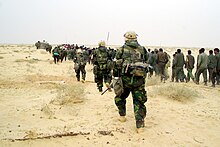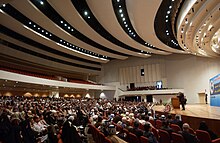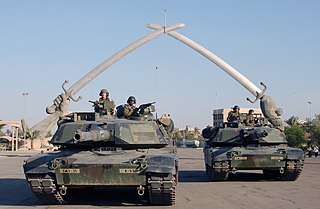Overview of articles
Top level overview articles

The following outline is provided as an overview of, and topical guide to, the Iraq War.
Iraq War – a protracted armed conflict in Iraq lasting from 2003 to 2011, which began with the invasion of Iraq by a United States-led coalition that overthrew the Iraqi government of Saddam Hussein. [1] [2] The conflict continued for much of the next decade as an insurgency emerged to oppose the coalition forces and the post-invasion Iraqi government. US troops were officially withdrawn in 2011. [3] [4] The invasion occurred as part of the George W. Bush administration's war on terror following the September 11 attacks. [5] [6]

| Events leading up to the Iraq War |
|---|
 |
|


Articles are sorted chronologically.
All battles are sorted in chronological order.

Attacks are sorted in chronological order.

War crimes are listed in roughly chronological order.

Protests are sorted in chronological order.
Groups are sorted in alphabetical order.
Scandals and controversies are sorted in roughly chronological order.

This is a timeline of the events surrounding the United States-led invasion of Iraq in 2003.

The United States-led invasion of the Republic of Iraq was the first stage of the Iraq War. The invasion began on 19 March 2003 and lasted just over one month, including 26 days of major combat operations, in which a combined force of troops from the United States, the United Kingdom, Australia and Poland invaded Iraq. Twenty-two days after the first day of the invasion, the capital city of Baghdad was captured by coalition forces on 9 April after the six-day-long Battle of Baghdad. This early stage of the war formally ended on 1 May when U.S. President George W. Bush declared the "end of major combat operations" in his Mission Accomplished speech, after which the Coalition Provisional Authority (CPA) was established as the first of several successive transitional governments leading up to the first Iraqi parliamentary election in January 2005. U.S. military forces later remained in Iraq until the withdrawal in 2011.

The Battle of Baghdad, also known as the Fall of Baghdad, was a military engagement that took place in Baghdad in early April 2003, as part of the invasion of Iraq.

The 2003 invasion of Iraq involved unprecedented U.S. media coverage, especially cable news networks.

The Occupation of Iraq (2003–2011) was characterized by a large United States military deployment on Iraqi territory, beginning with the US-led invasion of the country in March 2003 which overthrew the Ba'ath Party government of Saddam Hussein and ending with the departure of US troops from the country in 2011. Troops for the occupation came primarily from the United States, the United Kingdom, and Australia, but 29 other nations also provided troops, and there were varying levels of assistance from Japan and other countries, as well as tens of thousands of private military company personnel.

The following is a timeline of major events during the Iraq War, following the 2003 invasion of Iraq.
Events in the year 2004 in Iraq.

An Iraqi insurgency began shortly after the 2003 American invasion deposed longtime leader Saddam Hussein. It is considered to have lasted until the end of the Iraq War and U.S. withdrawal in 2011. It was followed by a renewed insurgency.
The following lists events in the year 2003 in Iraq.

There are various rationales for the Iraq War, both the 2003 invasion of Iraq and the subsequent hostilities. The George W. Bush administration began actively pressing for military intervention in Iraq in late 2001. The primary rationalization for the Iraq War was articulated by a joint resolution of the United States Congress known as the Iraq Resolution. The US claimed the intent was to "disarm Iraq of weapons of mass destruction, to end Saddam Hussein's support for terrorism, and to free the Iraqi people".
The following lists events that happened during 2006 in Iraq.

The Iraq War, sometimes called the Second Persian Gulf War was a protracted armed conflict in Iraq from 2003 to 2011. It began with the invasion of Iraq by the United States-led coalition that overthrew the Ba'athist government of Saddam Hussein. The conflict continued for much of the next decade as an insurgency emerged to oppose the coalition forces and the post-invasion Iraqi government. US troops were officially withdrawn in 2011.

The 1991 Iraqi uprisings were ethnic and religious uprisings against Saddam Hussein's regime in Iraq that were led by Shi'ites and Kurds. The uprisings lasted from March to April 1991 after a ceasefire following the end of the Gulf War. The mostly uncoordinated insurgency was fueled by the perception that Iraqi President Saddam Hussein had become vulnerable to regime change. This perception of weakness was largely the result of the outcome of the Iran–Iraq War and the Gulf War, both of which occurred within a single decade and devastated the population and economy of Iraq.

The Battle of the Karbala Gap occurred during the 2003 invasion of Iraq. The Karbala Gap is a 20–25-mile wide strip of land with the Euphrates River to the east and Lake Razazah to the west. This strip of land was recognized by Iraqi commanders as a key approach to Baghdad, and was defended by the Medina and Bakhtnisar Divisions of the Iraqi Republican Guard. American forces attacked Iraqi forces in the area with massive air attacks followed by concentrated armored thrusts which resulted in the Iraqi units being surrounded and annihilated.

Iraqi–Italian relations are the interstate ties relations between Iraq and Italy. Iraq has an embassy in Rome and Italy had an embassy in Baghdad and a consulate-general in Basra.

The Royal Tulip Al Rasheed Hotel is an 18-storey hotel in Baghdad, Iraq, often visited by journalists and media personnel due to its location within Baghdad's Green Zone. It is named after the eighth century Caliph Harun Al-Rashid. It has been a focal point in a number of conflicts in the region, most recently the 2003 U.S. invasion of Iraq.

Ra'ad Majid Rashid al-Hamdani is a retired Iraqi military officer and former General of the Iraqi Republican Guard, and was one of Saddam Hussein's favourite generals.
The timeline of the Gulf War details the dates of the major events of the 1990–1991 war. It began with the Iraqi invasion of Kuwait on 2 August 1990 and ended with the Liberation of Kuwait by Coalition forces. Iraq subsequently agreed to the United Nations' demands on 28 February 1991. The ground war officially concluded with the signing of the armistice on 11 April 1991. However, the official end to Operation Desert Storm did not occur until sometime between 1996 - 1998. Major events in the aftermath include anti-Saddam Hussein uprisings in Iraq, massacres against the Kurds by the regime, Iraq formally recognizing the sovereignty of Kuwait in 1994, and eventually ending its cooperation with the United Nations Special Commission in 1998.

The Iraqi conflict is a series of violent events that began with the 2003 American-led invasion of Iraq and deposition of Iraqi president Saddam Hussein, the most recent of which is the ISIS conflict, in which the Iraqi government declared victory in 2017.
{{cite web}}: CS1 maint: unfit URL (link)